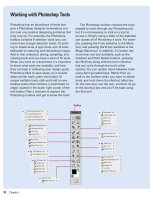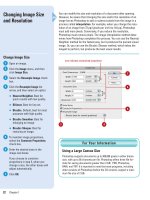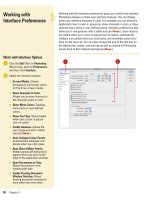Photoshop cs5 by steve Johnson part 56 potx
Bạn đang xem bản rút gọn của tài liệu. Xem và tải ngay bản đầy đủ của tài liệu tại đây (985.89 KB, 6 trang )
ptg
Chapter 14 Manipulating Images with Filters 347
When Adobe introduced the Filter Gallery in Photoshop, it finally gave
designers the ability to view the effects of multiple filters applied to a
single image. While this changed forever how we apply filters to an
image, there is one more creative way to work—Blending Modes. For
example, you can make a copy of an image, apply a separate filter
effect to each layer, and then use the Blending Modes option to create
a totally different image. While this is not a new technique, the results
of combining two or more layers together, each with a different filter
effect, can produce quite stunning results.
Blending Modes and
Filter Effects
Work with Blending Modes and
Filter Effects
Open an image.
Select the layer containing the
image you want to modify.
Press Ctrl+J (Win) or A+J (Mac)
to create a copy of the selected
layer.
Select the layers one at a time and
apply a different filter to each
layer.
Select the top layer.
Click the Blending Modes list
arrow and experiment with the
various blending options.
In this example, the Cutout and
Find Edges filters were used on
the separate layers, and then
combined with the Linear Light
Blending Mode.
6
5
4
3
2
1
1
Final image
with the Linear
Light Blending
Mode applied.
2
6
5
Did You Know?
You can use the Opacity option to fur-
ther control the final image.
If the
blending effect appears a bit too
intense, simply lower the opacity of the
top or bottom layer to change the
intensity of the filter effects.
From the Library of Wow! eBook
ptg
348 Chapter 14
The Pattern Maker filter (optional plug-in) lets you create your own dis-
tinctive patterns, based on image information in the active document, or
clipboard memory. Since the pattern is based on sample data, it shares
the visual characteristics of the sample. For example, if you sample an
image of a cloudy sky, the Pattern Maker generates a tile-like pattern
that is different from the sample but still retains the elements of a cloudy
sky. You can even generate multiple patterns from the same sample.
Building Custom
Patterns
Build Custom Patterns
Open a document.
Select the Layers panel, and then
select the layer you want to use to
create a pattern.
Click the Filter menu, and then
click Pattern Maker.
If the filter is not available, go to
www.adobe.com
, search for the
filter, and then download it.
Select the Rectangular Marquee
tool on the toolbox, and then
select a portion of the image.
Select the portion of the image you
want to use to generate an image.
Click Generate to create a random
pattern based on the selected
sample.
Click Generate Again to generate
another random pattern.
IMPORTANT
All the generated
patterns are stored in the Tile
History box, located on the bottom
right of the Pattern Maker dialog
box.
Select from the available Tile
Generation options:
◆ Use Clipboard As Sample. Uses
the pixel information contained
in the Clipboard as the tile-
generating pattern.
◆ Use Image Size. Creates a tile
pattern the size of the original
image.
8
7
6
5
4
3
2
1
7
4 6
5
From the Library of Wow! eBook
ptg
Chapter 14 Manipulating Images with Filters 349
◆ Width. Enter a value (1 to 800),
or click the black triangle and
drag the slider left or right to
define a width.
◆ Height. Enter a value (1 to 800),
or click the black triangle and
drag the slider left or right to
define a height.
◆ Offset. Click the list arrow, and
then click None, Horizontal, or
Vertical.
◆ Amount. Enter a percentage
value (1% to 100%), or click the
black triangle and drag the
slider left or right.
◆ Smoothness. Click the list
arrow, and then select a value
of 1, 2, or 3.
◆ Sample Detail. Enter a value
from 3 to 21, or click the black
triangle and drag the slider left
or right.
◆ Show. Click the list arrow, and
then select between the
generated sample and the
original image.
◆ Tile Boundaries. Select the
check box to view the tile
edges in the preview window.
Click on the color box, and then
select an alternate color.
Scroll through your tile patterns
using the left/right arrow keys
underneath the Tile History
preview. Stop when you see the
pattern you want.
Click OK.
IMPORTANT
When you click
OK, the Pattern Maker filter over-
writes the original image, so it's a
good idea to make a copy of the
image in a separate layer before
using the Pattern Maker filter.
10
9
10
8
9
Using Pattern Maker
Custom patterns can be generated from any RGB, Grayscale, CMYK,
or Lab Color mode graphic image. In addition, when you create a
pattern, the original image is overwritten with the new pattern, so
you can use the generated pattern, reopen the Pattern Maker filter,
and then create new patterns from the pattern you just created.
For Your Information
From the Library of Wow! eBook
ptg
350 Chapter 14
Photoshop's Fade command is a one-shot chance to change your mind.
For example, you've just applied the Find Edges filter to an image. You
like the look but the effect is too dramatic. What you really want to do
is tone down the effect. Unfortunately, filter effects don't fade like a
gradient; they are simply applied, all or nothing, to the image. You could
create a copy of the original layer, apply the effect to the copy, and
then use Layer transparency and blending mode options to merge the
effect with the image, but there's an easier way. Just use the Fade
command.
Using the Fade
Command
Use the Fade Command
Open a document.
Select the Layers panel, and then
select the layer to which you want
to apply a filter.
Click the Filter menu, and then
click Filter Gallery.
Apply any of Photoshop's filters to
the active image.
Click OK.
Click the Edit menu, and then click
Fade. The Fade command includes
the name of the applied filter.
IMPORTANT
The Fade
command must be executed
before performing any other
command. Once you execute
another command, the ability to
modify the last filter is lost.
Change the Opacity and Mode
settings until you see the effect
you're after.
Click OK.
8
7
6
5
4
3
2
1
1
8
Filter effect and
Fade applied
7
Did You Know?
You can use the Fade command with
almost any filter or drawing tool.
Every
time you draw, use a command or use
a filter, the Fade command gives you a
one-shot chance to fade and blend.
From the Library of Wow! eBook
ptg
Chapter 14 Manipulating Images with Filters 351
When you apply a filter to an image, Photoshop applies the filter
equally to the entire image. Unfortunately, that might not be what you
had in mind. For example, you might want to apply the Gaussian Blur fil-
ter to a portion of the image. In that case, Photoshop's selection tools
come to the rescue. The primary purpose of making a selection is to
define a work area, and when you select an area before applying a fil-
ter, the only area impacted by the filter will be the selected area.
Controlling Filters
Using Selections
Control Filters Using Selections
Open a document.
Select the Layers panel, and then
select the layer to which you want
to apply a filter.
Click one of the selection tools on
the toolbox, and then create a
selection in the document window.
Click the Filter menu, and then
click Filter Gallery.
Select any of Photoshop’s filters.
Adjust the filter options until you
see the effect you want.
Click OK.
The filter is only applied to the
selected areas of the image.
7
6
5
4
3
2
1
1
Selection
See Also
See Chapter 4, “Mastering the Art of
Selection,” on page 77 for more infor-
mation on creating selections.
5 6
7
From the Library of Wow! eBook
ptg
352 Chapter 14
Photoshop's filters can be applied to any raster image. In addition, fil-
ters can be controlled with the use of selections. You can use any of
Photoshop's selection tools to define a working area. However, simple
selections are limited in what they can do. Although the edge of selec-
tions can be modified by feathering, the inside area of the selection is
completely selected. What if you want to apply a filter in a completely
different way? For example, what if you want to apply a filter that is
stronger on the right side of the image, and slowly tapers off from left
to right? In that case a simple selection won't help, but a Channel mask
will do exactly what you need.
Using a Channel
Mask to Control
Filter Effects
Use a Channel Mask to Control
Filter Effects
Open a document.
Click the Channels panel, and then
click the Add New Channel button.
Select the Gradient tool on the
toolbox, click a linear gradient,
select the default foreground and
background colors of black and
white, and then drag left to right
across the new channel mask.
Photoshop creates a horizontal,
black to white channel mask.
Select the Layers panel, and then
select the layer containing the
image you want to modify.
4
3
2
1
3
1
4
See Also
See Chapter 10,“Creating Masks,” on
page 243 for information on using
Channel Masks.
From the Library of Wow! eBook









